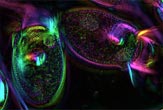
In 1702, the famous Dutch scientist Anton van Leeuwenhoek made an interesting discovery while gazing at some pond water through a hand-made microscope: He observed a bell-shaped organism that used a long, rapidly contracting stalk to attach itself to objects in its environment.
More than 300 years after Leeuwenhoek first observed Vorticella convallaria, as the microscopic pond organism is now called, scientists are finding that its spring-like stalk is one of the fastest cellular engines ever discovered.
Danielle Cook France, a biological engineer at the Massachusetts Institute of Technology, believes the stalk could be incorporated into future generations of nano-sized cellular engines.
Nanomaterials typically involve a measurement of at least one dimension that is 100 nanometers or less. A human hair is roughly 100,000 nanometers wide.
The spring in the stalk is made up of contractile protein fibers and is called a "spasmoneme." At rest, the stalk is elongated like a stretched telephone cord, but when contracted, it winds back in a flash to form a tight coil.
Using high-speed microscopes and special chemicals that could freeze the stalk in mid-coil, France and colleagues were able to take snap-shots of the stalk as it contracted.
The researchers estimated that Vorticella's spasmoneme could contract at a speed of about 8 centimeters per second. That's the equivalent of you walking the length of more than three football fields in one second.
Sign up for the Live Science daily newsletter now
Get the world’s most fascinating discoveries delivered straight to your inbox.
Researchers think a cellular protein known as spasmin is responsible for Vorticella's remarkable speed. Spasmin belong to a family of proteins called centrins; in humans and other organisms, centrins play an important role in cell division.
"If it's knocked out in yeast, for example, the cells don't divide at all," France said.
Unlike many other cellular proteins, centrins aren't powered by ATP, a high-energy molecule that drives many biochemical reactions; instead, they run on calcium.
France said that from an engineering perspective, using calcium to power a mechano-chemical engine is ideal because it's a fuel that can't be burned up. ATP can only be used once and then must be recycled by the cell.
Calcium, in contrast, doesn't need to be recycled and provides power through changes in concentration. So the only limitation to its use as an energy source is the speed at which the cell can pump calcium between different compartments.
France said her team is currently working on making fibers out of spasmin-type proteins but she thinks the nano-springs could find other applications as well.
"Anywhere that you would need movement to be created in a small device, that's where you would use these," France said.
France presented her findings Sunday at the 45th Annual Meeting of the American Society for Cell Biology in San Francisco.









